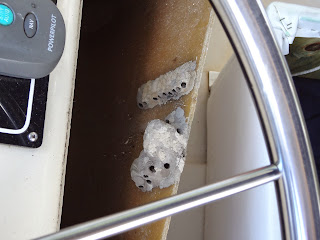The first project that I worked on was the completion of my VHF radio upgrade.
When we bought the boat it came with two VHF radios that were both more than a decade old. Besides not having DSC (Digital Selective Calling) capabilities, the radio on the flybridge was starting to die.
I decided to replace both with a Standard Horizon GX-2150+, which not only is a modern DSC capable radio, but also has AIS (Automatic Identification System) receive capabilities.
Rather than go with two VHF radios again, I decided to go with a single radio, located at the lower helm, and use a RAM3 CMP-30 remote mic for the flybridge. We still had an old VHF handheld for a backup, but I picked up a new Standard Horizon HX-290 as a primary backup, as well as a radio to use on the flybridge until I finished the RAM3 installation.
Another side benefit of going with the single radio is that it freed up one of the antenna mounts that can now be re-purposed, and will eventually be used as a mount point for an Amateur Radio HF antenna.
Installing the GX-2150+ at the lower helm was relatively easy. It was pretty much a straight swap out for the radio that was at the lower helm, and I completed that the week before Canada Day.
To finish the project though meant that I had some cable runs to do between the flybridge and the lower helm. First I had to run the interface cable between the radio and the remote mic. Second I had to run an NMEA cable to interface between the chartplotter and the radio. In order to do the AIS receive function, the radio needs to have GPS data. As well, it also sends the AIS target information back to the chart plotter to be displayed as a data layer overlay.
Finally, I had to run a cable to connect the PA/Fog-horn, which was previously connected to the flybridge radio, to connect it to the new radio at the lower helm.
The first step was gaining access to the cabling space under the flybridge dash. Imagine my surprise when I cracked the panel and found this;
 |
| Flybridge wasp nests |
After cleaning up the nests I got to work running the cables I needed. Unfortunately this also involved a number of new holes being drilled. This is something that no boat owner enjoys, but it was required.
I completed the cable runs on Wednesday and called it a day. Today I worked on getting everything connected up.
The first connection I did was the remoting cable for the RAM3 mic. I was lucky in that I could route the cable between the helms without having to cut the cable, and subsequently splice it back together.
Next I worked on the NMEA connection between the chartplotter and the radio. One of the things I had wanted to do and did today was to wire the chartplotter in properly at the flybridge. Previously it had a cable that had a 12v plug on the end, which you plugged in at a 12v socket on the flybridge or lower helm to use. Because I had to wire in the NMEA connection I also wired the power in as well, and routed it through the flybridge dash. I'm waiting for a second A-50D power/signal cable to come in at Marine Outfitters. Once that comes in I'll do a similar setup at the lower helm.
I wired the NMEA connections on the A-50D cable to the NMEA cable that I ran yesterday. At the lower helm I connected the NMEA cable to a 4 pin plug, and the radio side of the NMEA connection to a 4 pin socket. I ran it through a plug rather than connecting directly so that if I needed to take the radio down for any reason there was no permanent connections that would have to be cut.
After checking all my connections I ran through the NMEA setup on both the chartplotter and the radio, both of which supported a 38400 data speed. It was quite the thrill to hook everything up and see the GPS information on the radio. I'll have to wait until we're back near Kingston next week to see how the AIS display works.
I was already quite impressed with the GX-2150+ radio, but I was also very pleased with how well the RAM3 remote mic works. It has more than enough volume and all of the radio's functions can be accessed from the remote mic.
 |
| Standard Horizon GX-2150+ |
 |
| Standard Horizon RAM3 remote mic |

Nice! Not fun running cabling through boats or cars when installing these things. Was a bit confused until I seen that the remote mic also has a speaker, guess it's more of a 2nd faceplate with mic :-) Question, if you have a ham license already, do you need to take the VHF course to be licensed on the boat for the marine radio? I ask as a friend of mine just
ReplyDeletebought a new boat (Hunter 33) and it has VHF onboard but he indicated he can't use it until he takes a 1 day course....I found this a bit strange but if that is the regulation how does that effect those of us who are licensed for other bands?
If you do a stroll through the Industry Canada RIC page (http://www.ic.gc.ca/eic/site/smt-gst.nsf/eng/h_sf06073.html) you'll see there's a lot of different licenses. The ROC(M) (Restricted Operator's Certificate (Maritime)) is just one of the maritime licenses.
ReplyDeleteThat being said, the ROC(M) course and test were not very tough, so I'd say it's more of a benchmark of basic operator proficiency than any measure of real technical competency.
So, the bottom line is that you do need to have the ROC(M) card to be legal.